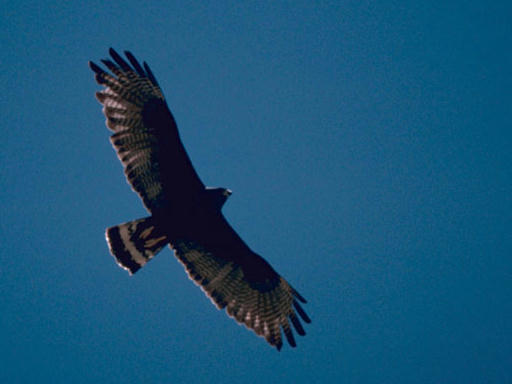- Zone-tailed Hawk
Taxobox
name = Zone-tailed Hawk
status = LC | status_system = IUCN3.1

regnum =Animal ia
phylum = Chordata
classis = Aves
ordo =Falconiformes
familia =Accipitridae
genus = "Buteo "
species = "B. albonotatus"
binomial = "Buteo albonotatus"
binomial_authority = Kaup,1847 The Zone-tailed Hawk, "(Buteo albonotatus)", is a medium-sized hawk of warm, dry parts of the
Americas . It feeds on smallvertebrate s of all kinds (other than fish), includingbird s up to the size ofquail .Grown birds are 47-55 cm (18.5-21.5
inch es) in length with a wingspan of about 1.2 m (4 feet); their average weight is 810 g (1.8 lbs). Adultplumage is mostly blackish except that the flightfeather s are barred with lighter gray (appearing solid gray from a distance) and the tail has three or four bands or "zones", white from below and light gray from above, of which the one second from the tip is particularly broad and conspicuous. Thecere and legs are yellow. Immatures are similar except for small white spots on the breast and tails with narrow gray and black bands and a broad dark tip.The bird's plumage closely resembles that of theTurkey Vulture , and Zone-tailed Hawks soar with their wings held above the horizontal, rocking from side to side, like Turkey Vultures and often in company with them. As Turkey Vultures seldom prey on healthy animals, some ornithologists believe that thismimicry tricks potential prey animals into not being alarmed when a zone-tail flies overhead (Clark 2004). Bird guides caution against confusing it with the much more common Turkey Vulture, but at a reasonable distance one can see the smaller size, the typical hawk shape of the wings and head, and the pale stripe on the tail.The call is a loud scream dropping in pitch at the end. In at least some birds, there is an abrupt rise in pitch (like a break to a
falsetto voice) in the middle and an equally abrupt drop back down.Zone-tailed Hawks range from parts of
Arizona ,New Mexico , and westernTexas to southernBrazil ,Paraguay ,Bolivia , and northernArgentina . In winter they generally withdraw from the U.S. part of their range. They sometimes wander out of their normal range, and the bird was once recorded inNova Scotia . Their habitat is canyons with open woods in arid or semi-arid regions, though birds may hunt outside of canyons.The nest is typical of hawks: a big assemblage of sticks built in the leafy top of a tree (usually tall) or on a cliff. The clutch comprises two or three white eggs, often marked with brown.
References
* Database entry includes justification for why this species is of least concern
*
*
*cite web | last = Jiménez | first = Mariano G | coauthor = Mariano Jiménez II | title = Gavilán Oscuro | work = El Zoológico Electrónico | url = http://www.damisela.com/zoo/ave/otros/falcon/accipitridae/accipitrinae/buteo/albonotatus/index.htm | accessdate = 2006-07-21External links
* [http://www.npwrc.usgs.gov/resource/birds/forest/species/butealbo.htm Zone-tailed Hawk page from the USGS Northern Prairie Wildlife Research Center]
Wikimedia Foundation. 2010.
